Difference between revisions of "Infrastructure"
(→Auditorium) |
(→Virtulab) |
||
| Line 37: | Line 37: | ||
</table> | </table> | ||
| − | |||
| − | |||
| − | |||
| − | |||
| − | |||
| − | |||
| − | |||
| − | |||
| − | |||
| − | |||
| − | |||
| − | |||
| − | |||
| − | |||
| − | |||
| − | |||
| − | |||
| − | |||
| − | |||
===Auditorium=== | ===Auditorium=== | ||
Revision as of 12:42, 21 May 2013
Contents |
StarCAVE
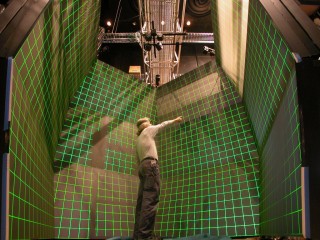 |
The StarCAVE consists of five walls with three screens each, plus floor projection. Two JVC HD2K projectors generate a stereo image for each screen, plus four projectors for the floor, totalling 34 projectors. Every projector pair is driven by a Dell XPS computer running under CentOS Linux version 6, with dual Nvidia GeForce GTX 285 graphics cards and a 10 Gigabit NIC. We use an additional XPS machine as the head node to control the rendering cluster, for a total of 18 nodes. For user tracking and interaction we use a wireless, optical tracking system by ART Tracking. It consists of four infrared cameras and a Flystick2 3D joystick. We currently support two software environments to drive the StarCAVE: Calit2's own CalVR and COVISE. But any Linux-compatible OpenGL-based application can be ported to the StarCAVE. The StarCAVE is located on the first floor of Atkinson Hall in room 1608a and can be booked on recharge. |
NexCAVE
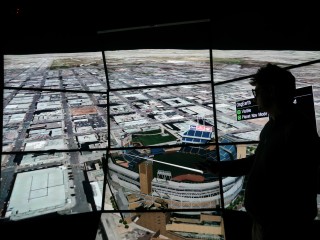 |
The NexCAVE was inspired by the StarCAVE and designed and developed by Calit2 Research Scientist Tom DeFanti, Virtual Reality Design Engineer Greg Dawe, Research Scientist Jürgen Schulze and Visualization Specialist Andrew Prudhomme. The Calit2 NexCAVE includes of 17 JVC Xpol (cross-polarized) panels, arranged into five columns, and produces data resolution close to human visual acuity (defined as “20/20 vision”). The Calit2 NexCAVE has an effective resolution of 10,000 x 1,500 pixels per eye. The JVC HDTV Xpol panels are very bright, which means that, unlike the StarCAVE, the NexCAVE can be used under normal room light levels. The NexCAVE is powered by 9 high end graphics PCs running under CentOS 6, with dual Nvidia 480 graphics cards. An additional graphics PC serves as the head node to control the rendering cluster. For user tracking and interaction, we use the optical tracking system TrackPack by ART Tracking. It consists of two infrared cameras and wireless tracking targets. A Saitek game pad serves as the input device. We support the same software environments as in the StarCAVE. The NexCAVE cannot be reserved separately, but is part of any StarCAVE reservation. |
TourCAVE
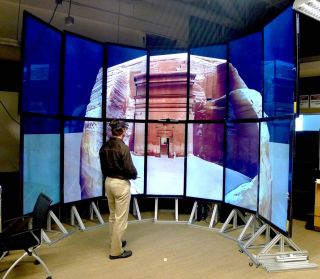 |
The TourCAVE is a lower cost version of the NexCAVE. It consists of 14 65" LG 3DTVs which we turned on their sides. The displays support passive stereo with circular polarization at full HD resolution. Our system has roughly 28 Megapixels, or 14 Megapixels per eye (7560x3840 pixels). The TourCAVE is powered by 7 high end graphics PCs with dual Nvidia GeForce 580 graphics cards. We use an ART Smarttrack system for head and wand tracking, and use a Gyration Gyromouse as the input device. Both COVISE and CalVR are installed in the TourCAVE. |
The Big Wall in the Vroom
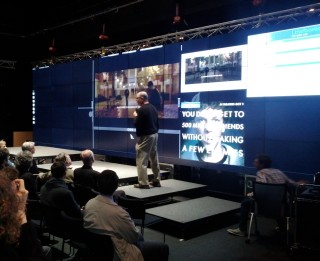 |
The Big Wall in the Vroom (Virtual Room) is a tiled display environment with four rows of eight displays for a total of 32 narrow-bezel LCD displays from NEC with a 55" screen diagonal. Each of the displays has full HD resolution (1920x1080 pixels), adding up to 66 million pixels on the entire wall (15,360 x 4,320 pixels). We also support multi-channel audio, and use a four-camera optical tracking system from Vicon. All displays have been attached in 2x2 patterns to mounting structures, which are either installed in movable containers (OptiPortables) or suspended from above. The displays in the Big Wall are driven by 16 rendering PCs running CentOS Linux, each with dual Nvidia Geforce 580 graphics cards. Additionally, there are three separate control PCs (head nodes), each of them set up for one of the three supported software environments: CGLX, CalVR and SAGE. |
Auditorium
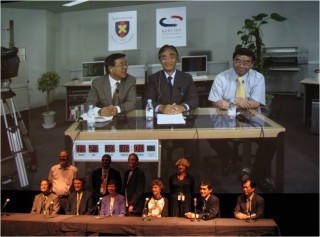 |
Calit2's digital theater auditorium offers 200 seats with power and ethernet jacks in every seat. The high end technical equipment installed in this room allows it to be used for anything ranging from presentations with Powerpoint slides, video screenings, presentations of visual and performance art, to demonstrations of the future of digital cinema: 4k video on a 18 by 32 foot screen. Among the technical highlights of the auditorium are: a 20 channel surround sound system, high definition (HD) video playback from computers or digital HD tapes, real-time virtual reality with a 3D tracking system, and a Sony SRXD-R110 4k projector (4096x2160 pixels resolution). The control room houses the following 4k-relevant hardware:
Other equipment used in the digital theater includes a digital light mixer, a conventional projector by Christie with a resolution of 1600x1200 pixels, and a remote control system by Crestron which allows presenters to connect their laptops and control video and audio directly from the podium. |